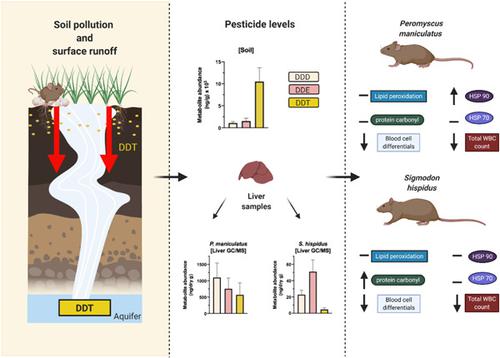当前位置:
X-MOL 学术
›
Environ. Toxicol. Chem.
›
论文详情
Our official English website, www.x-mol.net, welcomes your feedback! (Note: you will need to create a separate account there.)
Chronic Exposure to Environmental DDT/DDE in 2 Species of Small Rodents: Measures of Contaminant Load, Immune Dysfunction, and Oxidative Stress
Environmental Toxicology and Chemistry ( IF 4.1 ) Pub Date : 2021-02-04 , DOI: 10.1002/etc.5007 Erica M Molina 1 , Andreas N Kavazis 2 , Mary T Mendonça 1
Environmental Toxicology and Chemistry ( IF 4.1 ) Pub Date : 2021-02-04 , DOI: 10.1002/etc.5007 Erica M Molina 1 , Andreas N Kavazis 2 , Mary T Mendonça 1
Affiliation

|
Persistent contaminants are ubiquitous in our water and soil, and thus chronic exposure to environmentally relevant levels of these contaminants may pose a risk to humans and wildlife. Two species of small mammals (deer mouse, Peromyscus maniculatus and cotton rat, Sigmodon hispidus) were collected from historically dichlorodiphenyltrichloroethane (DDT)-contaminated and reference areas at the Redstone Arsenal (Huntsville, AL, USA), a US Environmental Protection Agency (USEPA)-designated Superfund site. Soil samples taken concurrently with mammal collection from the DDT abatement site exhibited DDT and dichlorodiphenyldichloroethylene (DDE) levels >1 ppm (USEPA total threshold limit concentration for DDT and DDE <1 ppm), whereas soil samples from the reference area had undetectable levels. Liver samples from individuals of both species collected in the contaminated areas also had significantly elevated DDT/DDE levels, with P. maniculatus averaging an approximately 20× greater load than that documented for S. hispidus. Both rodent species collected from the contaminated site had significantly lower total leukocyte counts and total differential blood cell counts (p = 0.01 and p = 0.04, respectively) than those collected from the nearby (~7000-m) reference site. Cellular stress indices also trended higher in both species, suggesting a potential for chronic exposure to DDT to act as a mediator of oxidative damage. The present study provides support to the idea that environmental exposure to low levels of contaminants can cause physiological consequences that may influence immune responsiveness and initiate cellular stress in resident mammals. Environ Toxicol Chem 2021;40:1619–1629. © 2021 SETAC
中文翻译:

2 种小型啮齿动物慢性接触环境 DDT/DDE:污染物负荷、免疫功能障碍和氧化应激的测量
持久性污染物在我们的水和土壤中无处不在,因此长期暴露于环境相关水平的这些污染物可能对人类和野生动物构成风险。两种小型哺乳动物(鹿鼠、Peromyscus maniculatus和棉鼠、Sigmodon hispidus) 是从美国环境保护署 (USEPA) 指定的超级基金站点 Redstone Arsenal (Huntsville, AL, USA) 历史上被二氯二苯基三氯乙烷 (DDT) 污染的参考区域收集的。与从 DDT 减排地点采集哺乳动物同时采集的土壤样本显示 DDT 和二氯二苯二氯乙烯 (DDE) 水平 > 1 ppm(美国环保署 DDT 和 DDE 总阈值限制浓度 <1 ppm),而来自参考区域的土壤样本的水平无法检测到。在受污染地区采集的两种物种个体的肝脏样本的 DDT/DDE 水平也显着升高,其中P. maniculatus的平均负荷比记录的S. hispidus高约 20 倍. 从污染地点收集的两种啮齿动物的总白细胞计数和总分类血细胞计数(分别为p = 0.01 和p = 0.04)明显低于从附近(~7000 米)参考地点收集的啮齿动物。这两个物种的细胞应激指数也呈上升趋势,这表明慢性接触 DDT 有可能充当氧化损伤的介质。本研究支持这样一种观点,即环境暴露于低水平的污染物会导致生理后果,这些后果可能会影响免疫反应并引发常驻哺乳动物的细胞应激。环境毒物化学2021;40:1619–1629。© 2021 SETAC
更新日期:2021-02-04
中文翻译:

2 种小型啮齿动物慢性接触环境 DDT/DDE:污染物负荷、免疫功能障碍和氧化应激的测量
持久性污染物在我们的水和土壤中无处不在,因此长期暴露于环境相关水平的这些污染物可能对人类和野生动物构成风险。两种小型哺乳动物(鹿鼠、Peromyscus maniculatus和棉鼠、Sigmodon hispidus) 是从美国环境保护署 (USEPA) 指定的超级基金站点 Redstone Arsenal (Huntsville, AL, USA) 历史上被二氯二苯基三氯乙烷 (DDT) 污染的参考区域收集的。与从 DDT 减排地点采集哺乳动物同时采集的土壤样本显示 DDT 和二氯二苯二氯乙烯 (DDE) 水平 > 1 ppm(美国环保署 DDT 和 DDE 总阈值限制浓度 <1 ppm),而来自参考区域的土壤样本的水平无法检测到。在受污染地区采集的两种物种个体的肝脏样本的 DDT/DDE 水平也显着升高,其中P. maniculatus的平均负荷比记录的S. hispidus高约 20 倍. 从污染地点收集的两种啮齿动物的总白细胞计数和总分类血细胞计数(分别为p = 0.01 和p = 0.04)明显低于从附近(~7000 米)参考地点收集的啮齿动物。这两个物种的细胞应激指数也呈上升趋势,这表明慢性接触 DDT 有可能充当氧化损伤的介质。本研究支持这样一种观点,即环境暴露于低水平的污染物会导致生理后果,这些后果可能会影响免疫反应并引发常驻哺乳动物的细胞应激。环境毒物化学2021;40:1619–1629。© 2021 SETAC


























 京公网安备 11010802027423号
京公网安备 11010802027423号